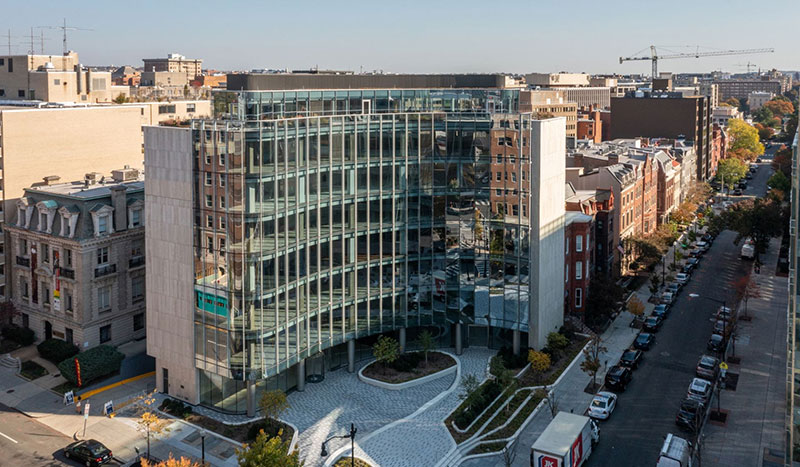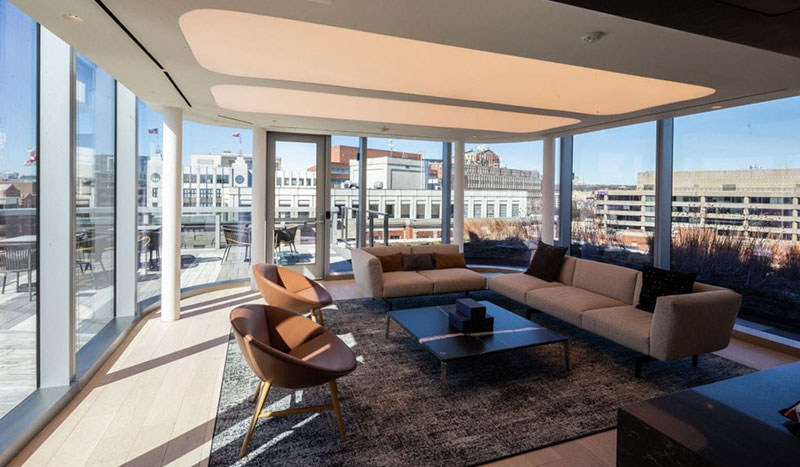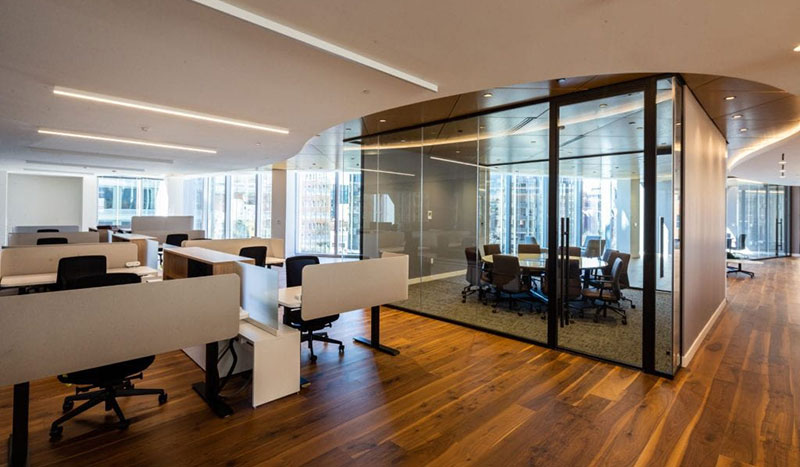
Originally built in 1968, the new University of Southern California building in Washington, D.C., was home for decades to the National Association of Broadcasters. (New Media Systems)
The University of Southern California (USC) spent $49.4 million in March 2023 to acquire an office building in Washington, D.C., and convert it into a satellite campus in the nation’s capital.
USC is one of numerous U.S. colleges and universities that are expanding their presence in cities, sometimes far from their main campuses. Many schools are converting older buildings into classroom, meeting, and performance spaces for educational use.
“A number of universities—large and small—are looking at tapping into other geographic markets by establishing a physical presence in them,” explains James Birkey, senior vice president for education at real estate services company JLL, which has studied the trend. “Not only does it provide an access point for academic exchange in the traditional sense, but it also increases institutional brand visibility and awareness in key markets.”
Washington, with its proximity to government agencies and national cultural institutions, has become one of the most popular locations for colleges and universities to expand. More than 30 higher educational institutions based elsewhere—ranging from Ohio State University and Massachusetts Institute of Technology to Pepperdine University–have opened educational facilities in the nation’s capital, according to a list compiled by JLL.
USC, which already had some Washington-based programs and offices, began looking for a larger site to create a satellite campus back in mid-2022, according to Brian K. Wilson, executive director for USC Real Estate and Development. Eventually, the university found a 60,000-square-foot (5,574 square meters), LEED-certified, crescent-shaped structure at 1771 N Street NW, near Dupont Circle. The building was “the best fit for our needs,” according to Wilson.
Originally built in 1968, the building was home for decades to the National Association of Broadcasters.Stream Realty Partners, a Dallas-based firm, acquired it in 2018. A major overhaul, designed by global design, architecture, engineering and planning firmHOK, upgraded the building with a new glass façade and entry plaza, among other improvements.
“Fortunately, the building had been completely renovated down to its frame, including all building systems,” Wilson said. “Some space was built out by the prior owner to model what might be. But the majority of the building is a blank canvas for our design. Based on our initial discussions with a variety of architects, we will be able to create an outstanding environment for the people who will occupy and use the building.”
USC already is using some of the building’s six floors for classes, meetings, and events, as it considers additional modifications to the building. “We are working on plans for use of the balance of the building based on our vision for the USC Capital Campus, and then we will build out the balance of our improvements,” Wilson says.
“The building will serve several purposes including classroom education, research, events such as forums with policy makers, exhibitions by our artists from our many disciplines, plus offices, media facilities and other event space to welcome the Washington, D.C., community and our 6,000 alumni who live and work in that area,” Wilson explains. At present, USC is the building’s lone occupier.

Above and below: Stream Realty Partners updated the existing office building near Dupont Circle in Washington, D.C. (Michael Cress/USC)
 Expanding in Other Cities
Expanding in Other Cities
Other universities have undertaken expansion projects in cities ranging from New York City to Atlanta and Louisville, according to a recent article inCoStar News. Los Angeles in particular is a hotbed of educational real estate. In June, UCLA announced that it was acquiring the 11-story historicTrust Buildingin downtown Los Angeles, originally built in 1928, for an undisclosed price. The structure, which includes 334,000 square feet (21,030 square meters) of space, will initially house programs for UCLA Extension, a continuing education division. Arizona State University already has established a satellite campus in Los Angeles the old Herald Examiner Building, which reopened in 2021. (The university recently further expanded its presence in Los Angeles, when its existing fashion design programjoined in a partnershipwith the Fashion Institute of Design and Merchandising, according to a university news release.)
“We assisted Arizona State University to acquire a location for their L.A. campus,” JLL’s Birkey explains. “They can offer in-person or hybrid programs to a student demographic that is not going to be able to make it to Tempe and, at the same time, increase ASU’s visibility and connectivity to the L.A. market—a market that the main Tempe campus already draws upon heavily. For the students that can’t come to your campus, you can bring the campus to them.”
While universities have utilized satellite campuses for decades as a way of accommodating additional students and boost their enrollment and revenues, “what is new is the competitive tenor of it,” Birkey says.
“There is a sense now that there are a limited number of potential students in the U.S., and institutions are competing for a piece of a limited pie,” Birkey explains. “In that sense, satellite campuses are tools to access market share, just like online platforms are.”
大学进入商业区不太可能provide a major stimulus to commercial real estate markets, said Birkey, but the economic benefits are multifold and longer term than some other tenants.
“The reality is that there is far more vacancy in the office market than there is demand for higher ed satellite space,” Birkey says. “However, universities locating satellite campuses in urban cores bring some distinct advantages—they typically focus on specific graduate and technical programs relevant to the city, advancing local industry synergies. That’s why, for example, you often see finance programs in New York, fintech programs in San Francisco, media programs in L.A., and policy programs in Washington.”
“这不仅吸引成年人的记述s the metro area to downtowns, but it keeps professional adjuncts and full-time faculty engaged in the urban environment,” Birkey says.
While universities can turn to adaptive reuse to reduce the cost of satellite campuses, the efficacy of that solution depends upon what sort of programs the buildings would house.
“The key element for the right space for these institutions lies in what programs they’re looking to locate at the satellite location,” Birkey says. “For example, theUniversity of the Pacific’s dental school in San Franciscois a highly specialized space and led toward a new-build solution.” In contrast, Johns Hopkins University’sSchool of Advanced International Studiesin Washington is moving in Fall 2023 into a 420,000-square-foot (39,039 square meters) Pennsylvania Avenue building that formerly housed the Newseum, where there’s enough space for 38 high-tech classrooms and a 375-seat theatre, according to the school’s website.
Most office buildings aren’t suitable for the sort of big lecture hall-scale classes that undergraduate introductory courses require. However, because many of the programs on the new satellite campuses are graduate-level, the classes can fit into the smaller spaces typically found in an office environment.
“Certainly, a mix of space sizing—and the ceiling heights that need to go with them—is preferred,” Birkey says.
Universities also may be attracted by potential bargains, due to softening demand for office space, particularly in older buildings. “We anticipate opportunistic plays from major institutions in urban markets,” Birkey notes.
“I think there are key institutions that are looking for very specific space in specific strategic places, and the economics are currently in their favor to find it,” he says.

